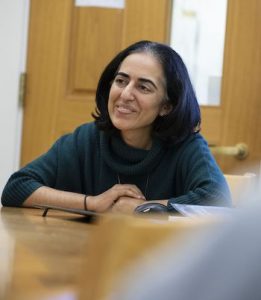
Indu Singh
Milton’s teachers spent the summer months planning and training for a variety of possible academic scenarios during COVID-19. Professional development programs and other Upper School initiatives focused on student-teacher connections, technology, curriculum design, anti-racism, transparency, equity, and assessment. Although the increased summer work was prompted by the ongoing pandemic, much of the planning will serve Milton long after the pandemic ends. Indu Singh, dean of teaching and learning, provided an insight into some of the initiatives in this Q&A.
What were some of the lessons learned from this spring, when Milton switched to a crisis remote-learning model at the outset of the COVID-19 pandemic in Massachusetts?
We learned that we needed to better balance synchronous class time and community-building with asynchronous learning—time away from screens. We had a pass/fail system in the spring because we couldn’t anticipate the impact of the pandemic on our students’ ability to put forth their best work. We are better prepared now to bring back grades; we also know much more about the technology and the crucial importance of making our teaching and our students’ learning more visible in remote spaces.
What does it look like to make our teaching and learning more visible? First, it means being even more specific in how we lay out a given task. Second, we will be asking students to make their thinking visible — perhaps they take a screenshot of a problem set they are working on, or type their thinking into a Google document after ten minutes of small group discussion. These are practices that should, and will, carry into the physical classroom when we’re all together again, as they help a teacher ‘see’ student thinking in given moments of time.
Can you describe the professional development teachers did this summer?
There were several opportunities for faculty. There was Global Online Academy, which was really good; it was related to the best techniques for setting up learning management systems, giving feedback, and cultivating relationships during online learning.
All faculty participated in a workshop on designing for remote and hybrid learning. Run by One Schoolhouse, an innovation partner with expertise in online and blended learning, the workshop provided a three-week program for our teachers. It offered a course-mapping exercise where units of study are designed to focus on competencies rather than learning tasks. Faculty also participated in two synchronous workshops run by EXPLO Elevate, an organization that helps schools design, build, and implement learning environments designed to help students thrive. In this workshop, faculty engaged on topics about teaching synchronous sessions and really concentrating on the relationships between students and teachers. We used diagrams to help us understand the proximity between a student and the teacher as well as to other students, a concept that will be very important in a hybrid or remote model.
How does competency-based curriculum help students?
Competency-based curricula cohere key aspects of teaching—course design, assessment, and feedback—around clearly identified learning outcomes. As a result, students are better able to see their growth, are positioned towards a growth mindset stance, and tend to take more ownership of their learning. For example, when a student receives feedback, it doesn’t just stop at, ‘Well, I got a B.’ They’ll be able to analyze it, for example, ‘Well, it looks like my ability to talk about an author’s word choice is really improving, but my ability to structure paragraphs is still not developed enough.’ The classes are about cultivating the skills of each discipline, and each teacher will set weekly objectives.
A key premise of our remote and hybrid learning plans requires making our teaching visible and student learning visible, because we don’t have eyes and ears in every student’s space. By naming objectives and outcomes we can make our teaching a lot more transparent, and it will help us develop a cadence for each unit of instruction.
What is a cadence, in the context of course planning?
The cadence we’ve identified for remote and hybrid learning establishes and normalizes key components of a learning cycle. Just as we want students to make their thinking visible to us in more deliberate ways, we also would like our teaching visible to our students; the cadence serves this purpose. The cadence begins with tone-setting, followed by assessing and sharing prior knowledge—what do the students already know about the topic?—including preconceived notions and assumptions. Then, there is intellectual play in the discipline, applying the concepts, followed by checking for understanding, reflection, and demonstrating understanding. Those are the critical components of any strong learning cycle.
The cadence builds metacognitive skills for students, helping them understand why they’re doing what they’re doing, and ultimately, how they learn.
Milton’s stated values for teaching for the 2020–2012 year are flexibility, structure, joy, and confronting white supremacy culture. How will teachers incorporate the concepts of diversity, equity, inclusion, and anti-racism across disciplines?
Anti-racist teaching creates space for the questioning of how we know what we know. What perspectives are missing? What biases and/or blindspots may have shaped current views? Our practices ask students to develop an awareness of the narratives that have been constructed within a given discipline, and in particular, the role of systemic racism within those narratives. Teachers are also creating more spaces in classes for students to process their awareness, whether that be with one another or individually. From a curricular standpoint, we have also redesigned courses to ensure that their content is inclusive of a diversity of perspectives and ideas that counter white supremacy and other forms of bigotry as they manifest in our disciplines and programs.